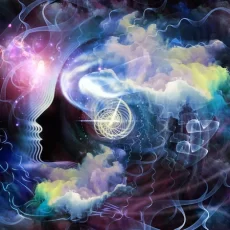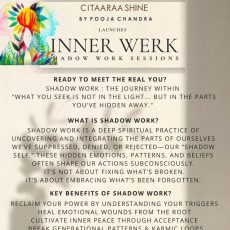Maa Prem Shashin
The focus of all spiritual schools is awareness and responsibility.
What is it to be aware? Watching the inner conversations in one’s mind, or being mindful is to be aware. Osho says: “Awareness means that whatsoever is happening in the moment is happening with complete consciousness; you are present there. If you are present when anger is happening, anger cannot happen. It can happen only when you are fast asleep. When you are present, immediate transformation starts in your being …in fact, there is only one sin, and that is unawareness.”
What is unawareness? Disconnection with what-is divides, from the situation us from the present. For example, when we are upset about a sudden turn in life or when we feel hurt about what we have heard – yet pretend to smile – we reject the stimuli of the heart and mind. Happy Ho organizes best Meditation and Tarot classes in Noida and Delhi NCR area in India.
Are love and awareness related? Yes. Love is the magic that helps to accept situations and people essentially as they are. Self-love is to accept yourself as you are or accept any situation as is. It is impossible to be conscious, aware if you repress feelings and thought. For example, when you are lovingly absorbed in the cup of tea and feel the warmth of the cup, sipping and savouring the pure tea as it travels downward into the body it is to have tea with love and awareness. When you drop the tea unconsciously without appreciating it because of the pre-occupied brain, it is unawareness and robot-like.
The brain is a mechanism that works life-long and even after that. According to a new study, ’brain activity may continue for more than 10 minutes after the body appears to have died. Tests have shown that the patient’s brain appeared to keep working – experiencing the same kind of brain waves that are seen during deep sleep’.
The brain performs several functions and is mostly in a chaos of mixed thoughts, feelings, ideas, solutions, and memories ask for more ‘mental real estate’ while we try to focus on one thing at a time. It is this over functioning that confuses us. The intricate web of mixed thought(s) entraps us and we slip into a chain of thoughts. For example, when you see the mouth-watering image of chocolate cake in a hoarding, your mind virtually visits the bakery that you frequent, tastes it, enjoys the whiff and aroma of the bakery triggering a desire to have the cake. The image in the hoarding can initiate thoughts that trigger a series of thoughts. H. Norman DMin Wright wrote, “Many thoughts are automatic. You don’t sit around thinking what you are going to think about next. Slide into your consciousness so smoothly that you don’t even sense their entrance. Many of them are stimulated from past experience, attitudes, and beliefs. You build up storehouses of memories and experience retaining and remembering those things that you concentrate upon the most. Most people who worry are depressed, irritable or critical towards others and are depressed have automatic thoughts that are negative.” These are not real. Most people often tend to “over-analyse” and develop rigidity of thinking. ,
What stirs hectic thoughts?
Osho says that every child is born with tremendous love for himself but it is soon destroyed. The ‘love the other, not yourself’ mantra is thrust on him in his early years. He is told to love others and not be selfish. However, he witnesses disagreements between his parents who hold divergent views about even trivia. These end up in heated arguments, anger, violence, vengeance and hatred with no trace of love or kindness. So, he perceives that that is love. While growing up, he sees more such unconscious behaviour of adults, he is confused and programmed to repeat the same behaviour with this family and friends. So, when people are angry with him, he pushes it back on them. Which means anger is reflective – we get what we give.
Self-love has been tainted and associated with egoism, vanity, narcissism, non-humane, and sin while loving others is considered a virtue. Children are rewarded for loving others but rebuked and punished for loving themselves. Haunted by guilt, they constantly struggle as their minds take control of them and they are unable be love neither others nor themselves.
They begin to see the ugliness of their minds, in day to day transactions, but do not know that the mind is playing tricks. Over time self-dislike turns into hate. Like life and death, love and hate are the two sides of a coin. They then find faults in all their activities leading to self-denial, low self-esteem, sadness, shame and fear. Fault-finding grows so much on them that they extend it to others.
Next, children want to spend time with others to escape from their own viciousness at the cost of losing their time and space. Undernourished and distanced from themselves, they repeat this program with others. They find faults in others and so cannot be kind and loving to them.
A person who loves himself feels strong and respects himself. Joyous, he appreciates the love that he receives from others and respects others’ needs for warmth, care and love. His love reflects love and is extended to animals, birds, trees, oceans, sky, mountains etc. Osho says: “The first thing to remember is to be more loving to yourself… when you cannot love yourself, how do you expect others to love you? Everyone is condemned in his own eyes. The whole moralistic teaching gives you only one thing: techniques of self-condemnation – how to condemn yourself, how you are bad, a criminal, guilty, a sinner… What has happened out of such teaching? Nobody loves anybody. The person who condemns himself cannot love anybody”.
“Mind is basically indecisive and awareness is basically decisive. So any act of awareness is total, full without repentance… “So live meditatively. Let every action you do – walking, talking, eating, typing on the keypad, swimming, jogging, watching a film, desiring a gift – become an opportunity to watch in awareness”.
There is a need for a totally new language of health and happiness. It might appear difficult because of our age-old investments in hatred, “sadness and misery. ” But most of us feel an urgent need for changing the inner climate. So, we must invest in health and harmony and consider simple meditation techniques for being at peace with ourselves.
One such age-old, simple, effortless technique is breath watching. When we watch our mind even its nature is to spin thoughts from the past and the future – except be here and now- , it ceases to be. While it may sound to be easy, watching the breath continuously can be difficult because the mind drifts away easily from the present moment. Osho says that it is important to not censure yourself for slipping into thoughts. Whenever you remember that you had forgotten, do not regret or be guilt-ridden. Instead just return to watching your breath. Slowly, slowly the mind will intervene lesser and lesser and become friendly. As you keep watching the breath, slowly and slowly you imbibe it and know that ‘it is a knack and not practice.’
Aligned with your breath, watching the mind turns into a pleasant experience. You feel nourished and well-rooted in the present. This change of the inner climate nurtures the harmonious bridge with yourself and others.





